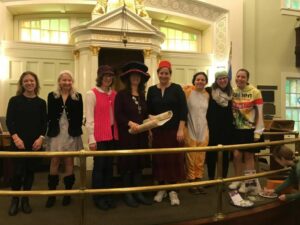
For the past 30 years, women have been chanting Megillat Esther, the scroll read on Purim, at Kesher Israel Congregation in Georgetown. Since ancient times, men have chanted the Megillah; however, women are allowed to as well according to Jewish law or Halacha.
Purim, a vibrant and joyous Jewish holiday, celebrates the salvation of the Jewish people in ancient Persia from a plot to annihilate them. It is observed on the 14th day of the Hebrew month of Adar, which usually falls in March. The story of Purim is recounted in the Book of Esther, also known as Megillat Esther.
This holiday is marked by several unique traditions. Among them is the reading of the Megillah, where the story of Esther, Mordecai and the villain Haman unfolds.
The story of Purim is set in the Persian Empire, where Queen Esther, secretly Jewish, and her cousin Mordecai, foil the plans of Haman, the king’s advisor, to kill all the Jews.
Esther bravely reveals her Jewish identity to King Ahasuerus, winning his favor and saving her people. The story highlights themes of courage, identity and the triumph of good over evil. Purim celebrates the victory of the Jewish people with joy and festivity, honoring Esther and Mordecai’s heroism.
The holiday serves as a powerful reminder of the resilience and survival of the Jewish people. Purim fosters community, encourages charity and celebrates freedom.
This annual women’s Megillah reading is not just an event, but it is a time for Orthodox women to find inclusivity and empowerment within an ancient tradition. Women come together as a community to share the story of how the Jewish people in Persia were saved by Queen Esther.
The inclusivity extends beyond the reading itself by introducing discussions about the importance of women’s voices in Orthodox Judaism.
“My father taught me how to chant the Megillah for my bat mitzvah, which at that point was a brand-new, kind of unheard-of mitzvah in the Orthodox Jewish community,” Alyza Lewin, the founder of this tradition at Kesher Israel, said.
From her bat mitzvah until now, Lewin has been a pivotal figure in this evolving ritual. Since her bat mitzvah, Lewin has pretty much chanted the Megillah every single year.
She feels a personal connection to the holiday because she has chanted it for so long. It greatly enhances the holiday for her, she said.
“It was very unusual at the time,” Lewin said. “I still remember girls at my gap year program in Israel recording on tape recorders and bringing it back to their parents to hear a woman chanting.”
The first all-women’s Megillah reading at Kesher Israel was on Purim 1994. Lewin and her husband moved to the area and joined the synagogue, and Lewin wanted to continue her tradition of chanting the Megillah.
At the beginning, Lewin chanted the entire Megillah herself. However, over time, she opened it up to volunteers. Volunteers used to often ask her for recordings of the chant, so they could practice it at home.
Over the years, Lewin noticed that young women were already familiar with how to chant before volunteering.
“In more recent years, I’ve had to do less and less because there are more and more women who have learned to chant who want to participate,” she said.
The women at Kesher Israel use Lewin’s personal Megillah for the reading. Lewin’s father had the Megillah commissioned years ago to be written for her in Israel. There is also a velvet cover with her name on it.
Lewin thinks some women continue to return to the women’s Megillah reading because they make a conscious effort to articulate and enunciate each word. It is easier to follow each word, she said.
“My role in the women’s Megillah reading is being supportive of it … I think it’s a wonderful thing and certainly halachically appropriate,” Rabbi Hyim Shafner of Kesher Israel said.
His advocacy underscores the communal and halachic acceptance of this practice.
One story Shafner shared stands out, illustrating the impact of this event beyond Kesher Israel’s walls. Two women from a traditional Hasidic background were visiting the synagogue, and they asked Shafner if women could actually read the Megillah.
“It was this eye-opening experience,” Shafner said.
Their astonishment upon realizing the Megillah could be read by women highlights the broader implications of Kesher Israel’s Megillah reading tradition for the Jewish community.
“This will be the 30th year … We did it through COVID. We had outdoor readings,” Lewin said.
“Whatever we can do … to be as inclusive as possible, we need to do that,” Shafner said.
Lewin’s initiative, supported by leaders like Shafner, continues to inspire, inviting every voice to be heard and every story to be valued.
This tradition serves as a testament to the adaptability of religious practices, showcasing how ancient traditions can evolve to embrace modern values without losing their halachic basis. Kesher Israel Congregation’s embrace of this practice demonstrates a commitment to inclusivity and progress within the framework of Halacha.
As the story of Megillat Esther continues to inspire, Kesher Israel’s women’s Megillah reading reminds us of the enduring call to stand up for what is right, echoing through the generations.
“It’s a story that at the end of the day celebrates women, and that is special,” Lewin said.





